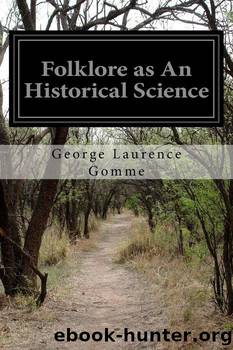Folklore as an Historical Science by George Laurence Gomme

Author:George Laurence Gomme [Gomme, George Laurence]
Language: eng
Format: epub
ISBN: 9781514159705
Barnesnoble:
Publisher: CreateSpace Publishing
Published: 2015-06-01T00:00:00+00:00
Long Meg and her Daughters (from a photograph by Messrs. Frith) LONG MEG AND HER DAUGHTERS
Stone circles on Stanton Moor (from Archæologia) STONE CIRCLES ON STANTON MOOR
This beginning shows the mark of the primitive mind, and that it was operating in a country dominated by scientific thought is the phenomenon which makes it so important to consider psychological conditions among the problems of folklore. They account for some beliefs which may not contain elements of pure tradition. When the Mishmee Hill people of India affirm of a high white cliff at the foot of one of the hills that approaches the Burhampooter that it is the remains of the "marriage feast of Raja Sisopal with the daughter of the neighbouring king, named Bhismak, but she being stolen away by Krishna before the ceremony was completed, the whole of the viands were left uneaten and have since become consolidated into their present form,"[256] we can understand that the belief is in strict accord with the primitive conditions of thought of the Mishmee people. Can we understand the same conditions of the parallel English belief concerning the stone circle known as "Long Meg and her daughters,"[257] and of that at Stanton Drew;[258] or of the allied beliefs in Scotland that a huge upright stone, Clach Macmeas, in Loth, a parish of Sutherlandshire, was hurled to the bottom of the glen from the top of Ben Uarie by a giant youth when he was only one month old;[259] and in England that "the Hurlers," in Cornwall, were once men engaged in the game of hurling, and were turned into stone for playing on the Lord's Day; that the circle, known as "Nine Maidens," were maidens turned into stone for dancing on the Lord's Day;[260] that the stone circle at Stanton Drew represents serpents converted into stones by Keyna, a holy virgin of the fifth century;[261] and that the so-called snake stones found at Whitby were serpents turned into stones by the prayers of the Abbess Hilda.[262] These are only examples of the kind of beliefs entertained in all parts of the United Kingdom,[263] and they seem based upon psychological, rather than traditional conditions.
The giant and the witch, or wizard, are terms applied to the unknown personal agent. "The two standing stones in the neighbourhood of West Skeld are said to be the metamorphosis of two wizards or giants, who were on their way to plunder and murder the inhabitants of West Skeld; but not having calculated their time with sufficient accuracy, before they could accomplish their purpose, or retrace their steps to their dark abodes, the first rays of the morning sun appeared, and they were immediately transformed, and remain to the present time in the shape of two tall moss-grown stones of ten feet in height."[264] This is paralleled by the Merionethshire example of a large drift of stones about midway up the Moelore in Llan Dwywe, which was believed to be due to a witch who "was carrying her apron full
Download
This site does not store any files on its server. We only index and link to content provided by other sites. Please contact the content providers to delete copyright contents if any and email us, we'll remove relevant links or contents immediately.
Cecilia; Or, Memoirs of an Heiress — Volume 1 by Fanny Burney(32020)
Cecilia; Or, Memoirs of an Heiress — Volume 3 by Fanny Burney(31436)
Cecilia; Or, Memoirs of an Heiress — Volume 2 by Fanny Burney(31379)
The Great Music City by Andrea Baker(30631)
We're Going to Need More Wine by Gabrielle Union(18600)
All the Missing Girls by Megan Miranda(14570)
Pimp by Iceberg Slim(13707)
Bombshells: Glamour Girls of a Lifetime by Sullivan Steve(13663)
Fifty Shades Freed by E L James(12885)
Talking to Strangers by Malcolm Gladwell(12812)
Norse Mythology by Gaiman Neil(12776)
For the Love of Europe by Rick Steves(11328)
Crazy Rich Asians by Kevin Kwan(8858)
Mindhunter: Inside the FBI's Elite Serial Crime Unit by John E. Douglas & Mark Olshaker(8662)
The Lost Art of Listening by Michael P. Nichols(7120)
Enlightenment Now: The Case for Reason, Science, Humanism, and Progress by Steven Pinker(6851)
The Four Agreements by Don Miguel Ruiz(6280)
Bad Blood by John Carreyrou(6251)
Weapons of Math Destruction by Cathy O'Neil(5797)
